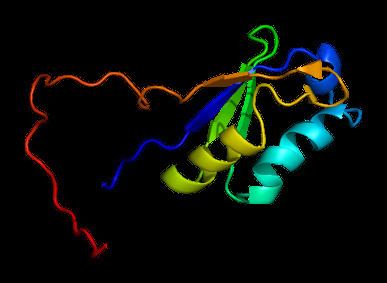Species Human Entrez 1827 | Human Mouse Ensembl ENSG00000159200 | |
 | ||
Aliases RCAN1, ADAPT78, CSP1, DSC1, DSCR1, MCIP1, RCN1, regulator of calcineurin 1 External IDs MGI: 1890564 HomoloGene: 3251 GeneCards: RCAN1 | ||
Down syndrome critical region gene 1, also known as DSCR1, is a protein that in humans is encoded by the DSCR1 gene.
Contents
Gene Location and Sequencing
DSCR1 in human is located at the centromeric border of the DSCR and encodes an inhibitor of calcineurin/ NFAT (nuclear factor activated T cells) signalling.
DSCR1 genomic sequence of total 45 kb contain 7 exons and 6 introns , different cDNA analysis yield first four exons are alternative and code for two isoforms of 197 amino acids , and one isoform code for 171 amino acids which differ in their N terminal . While the rest of the 168 residues are common. There is also alternative promotor region with about 900 bp between exon 3 and 4 suggesting that the fourth isoform might be penetrated from another promotor.
Function
The protein encoded by this gene interacts with calcineurin A and inhibits calcineurin-dependent signaling pathways of genetic transcription, possibly affecting central nervous system development. Three transcript variants encoding three different isoforms have been found for this gene. In endothelial cells, VEGF stimulates RCAN1.4 expression which regulates gene expression, cell migration and tubular morphogenesis.
Protein Structure
DSCR1 Consist of putative functional motifs and calcineurin binding domain. DSCR1 contains two proline-rich SH3 binding domain, usually named proline-rich domain (PRD), which defines the protein family. SH3 domains or PRD are very important to allow the binding of the protein to endocytosis-related proteins such as ITSN1 and amphiphysin 1 and 2.
Clinical significance
This gene is located in the minimal candidate region for the Down syndrome phenotype, and is overexpressed in the brain of Down syndrome fetuses. Chronic overexpression of this gene may lead to neurofibrillary tangles such as those associated with Alzheimer's disease.
Alzheimer disease and Down syndrome disease
All Down syndrome (DS) patients progress neuropathological changes identical to the pathogenesis of Alzheimer disease (AD) after their middle age, such as neurotic plaques and neuronal loss in their brain, Therefor, DS patients are perfect models to study AD pathogenesis. Chronic DSCR1 overexpression is related with DS and, while its shortage is reported in Huntington’s disease. DSCR1 expressed excessively in the Central nervous system of embryos during their development, this protein is later overexpressed in differentiating neurons regions such as Brains of DS patients. However, neurotrophic peptide PACAP (or Pituitary adenylate cyclase-activating peptide) which is responsible for the development, differentiation, and survival, and various parts of memory and learning, Target RCNA1 in a Down syndrome related gene, induces the expression of regulator of calcineurin 1, through activation of the PKA-CREB pathway, and this is important to understand the mechanisms of neural differentiation and aim for proper expression of RCAN1.
Cancer risk
It is suggested that the reason patients with Down's Syndrome are less predisposed to certain cancers is due to the impact of this gene of reducing blood supply to tumour cells. It is also proposed by epidemiological studies that DS patients are in greater risk of Leukaemia , on the other hand they are at lower risk of cancer and other angiogenesis related diseases such as Diabetic retinopathy and Atherosclerosis , indicating that one or more trisomic genes on chromosome 21 is responsible for protecting DS patients against cancer, and this cancer defence could be a result of angiogenesis suppression.
Interactions
DSCR1 has been shown to interact with Calcineurin.
Hydrogen peroxide (H2O2) increases the overexpression of protein RCAN1. However. Anti-oxidants and inhibitors of Mitogen-activated protein kinases(MAPK) treatment block the increased expression of RCAN1 by H2O2. Demonstrating that the increased expression is a result of generating reactive oxygen species and activation of MAPK. Furthermore, phosphorylation is important to regulator RCAN1 protein expression. Because phosphorylation of RCAN1 expression by H2O2 increases of the half-life of the protein.
